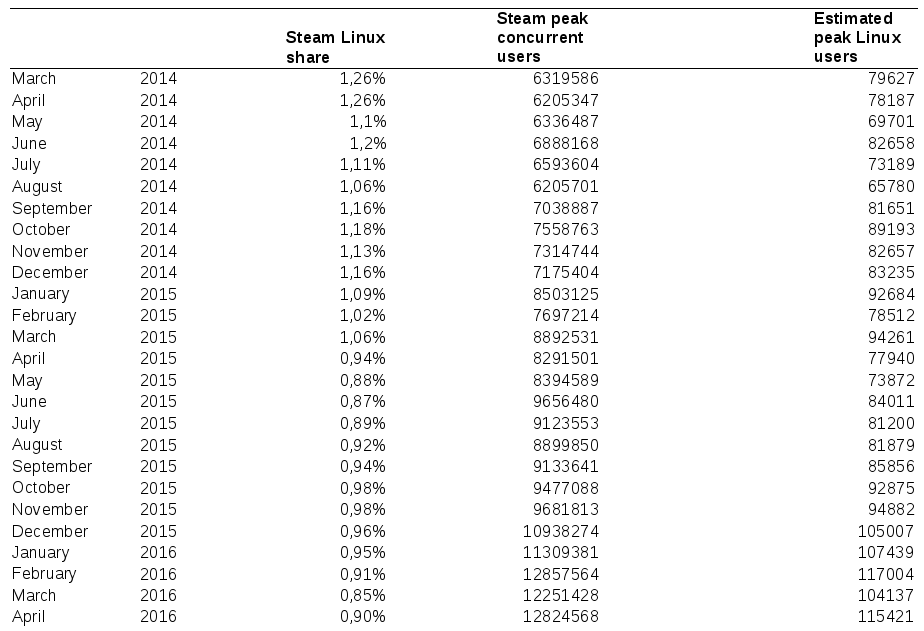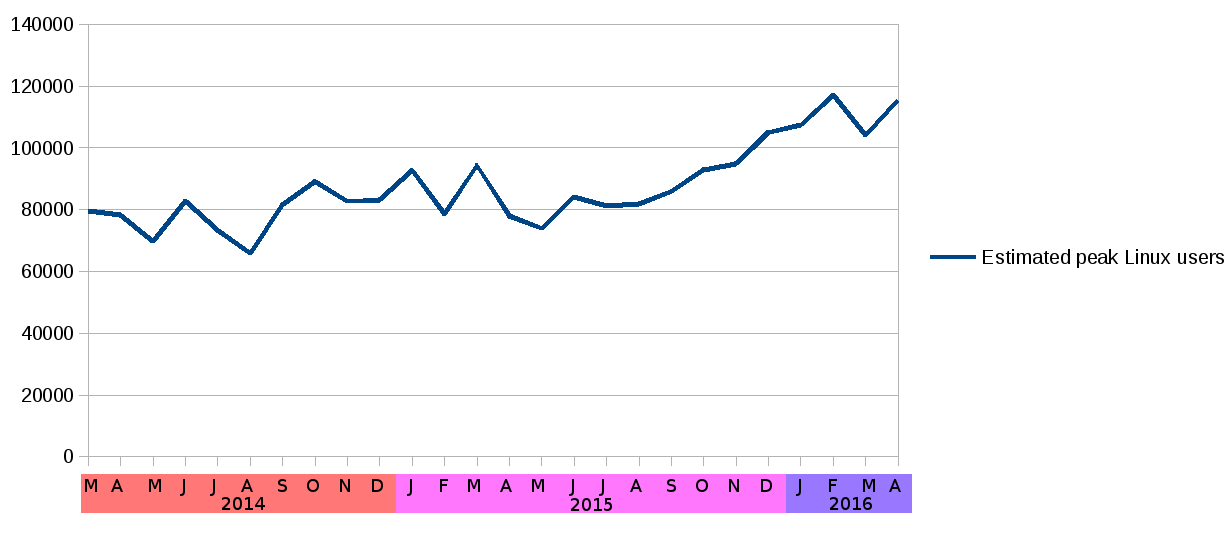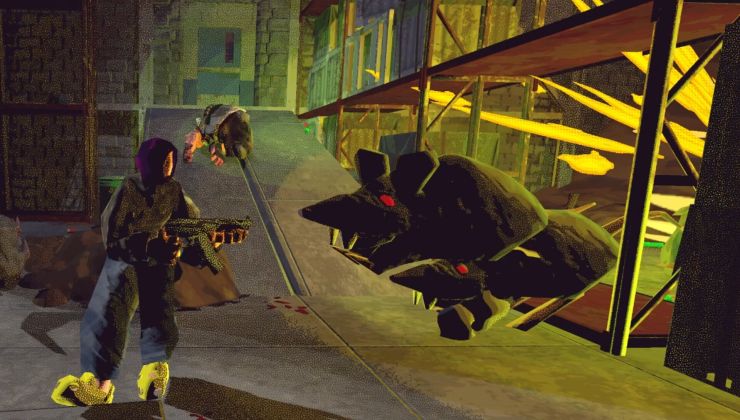Now that the monthly Steam statistics are out again, we can see that the result has increased slightly from last month, we are back up to 0.90% from 0.85%. While that is a positive sign, we are again looking at a number below 1% this month.
As has been previously pointed out there are a few flaws with the Steam statistics, such as that users of the Big Picture Mode do not get the survey at all. There are also likely a few flaws we don't know about. Still, we can safely assume that the Steam Hardware Survey isn't completely lying either: Linux usage might be off by a bit, but if it says below 1%, it is rather unlikely that the real numbers are for example above 2%. It is a statistic, and we have to treat it like a statistic, that gives us an indication of the Linux market share on Steam. An increase likely means a larger market share and a decrease a smaller market share.
A fair point that has been made, however, is that the amount of Steam users has been increasing over time. Therefore, it is reasonable to assume the number of Linux Steam users has increased as well. The question is: How did Steam grow?
A number that is often mentioned is that Steam had 125 million active users in February 2015. The problem with this number is that we don't have any more recent data, which makes it difficult to back claims that Linux game usage did increase. We really need data about Steam growth to say anything meaningful about the growth of Linux gaming on Steam.
This question was wandering around in my head for a while until I got an idea: Steam reports the peak concurrent users each day. This number would be a good an indication of the size of Steam, be it not for the fact that Steam only displays the number of the last day. The solution to this is the Wayback Machine. Using the Wayback Machine we can see archived copies of the Steam statistics page and therefore reconstruct the growth of Steam over the years. It also allows us to see the Steam Linux market share in past surveys. Luck is that the Wayback Machine archives the Steam statistics quite often so there is a lot of data available.
I have collected the data from March 2014 to April 2016, taking a sample around the 20th of each month, and used it to estimate the peak concurrent Linux users on Steam, by multiplying the peak concurrent users with the Linux share. Then you get these results:

Making a graph, we have a nice visualization of the growth of Linux gaming on Steam:

What we can now see, and this information is probably revealed for the first time, is that Linux use did largely remain flat until halfway through 2015. But since then, Linux gaming is in a steady growth trend!
Now is this a good or a bad thing? The good news is that we are growing and the growth seems steady. This is probably why professional game porters like Virtual Programming and Feral Interactive are doing well: Their market is increasing. As these companies generally port games that have already proven themselves, they are likely looking at increasing turnover.
However, it is also clear we are growing slower than the rest of Steam, and this is a point of concern. Why? The faster Steam grows, the more games there will be available (and in fact the number of games released monthly on Steam has grown during the last years). Our money will be spread over more games and if we were already insignificant, we will be even more insignificant for game developers. Numbers below 1% *are* pretty bad, there is no way to deny this.
However, the real question is what this will mean for the future: Steam has grown a lot. If Steam had 125 million users in February 2015, it should now have 185 million users. Will Steam be able to maintain this growth? If Steam maintains the current growth, it would need 270 million users halfway next year. I think this is rather unlikely, because you can already fit the entire population of a lot of countries in 185 million people, let alone 270 million.
Such an increase would be slightly more than the entire population of a big country like Germany joining Steam. I can't believe that. There are a limited number of Windows gamers and therefore the amount of potential Steam Windows users are not unlimited. Also, quite important is that competition for Steam is increasing, for example from the Windows store, but also from other publishers who want their own stores.
Therefore I assume that Steam Windows growth will stall at some point during 2016. But Steam Linux growth? There is a still a lot of potential for people switching to Linux, there is a lot less competition, and especially important, with initiatives like Steam Machines, the number of potential Steam Linux users has increased a lot. Therefore, when Steam growth stalls, because we have some momentum, we will have a lot of opportunity to catch up.
Conclusion: The statistics say that we haven't seen the best of Linux gaming yet, not by far.
As has been previously pointed out there are a few flaws with the Steam statistics, such as that users of the Big Picture Mode do not get the survey at all. There are also likely a few flaws we don't know about. Still, we can safely assume that the Steam Hardware Survey isn't completely lying either: Linux usage might be off by a bit, but if it says below 1%, it is rather unlikely that the real numbers are for example above 2%. It is a statistic, and we have to treat it like a statistic, that gives us an indication of the Linux market share on Steam. An increase likely means a larger market share and a decrease a smaller market share.
A fair point that has been made, however, is that the amount of Steam users has been increasing over time. Therefore, it is reasonable to assume the number of Linux Steam users has increased as well. The question is: How did Steam grow?
A number that is often mentioned is that Steam had 125 million active users in February 2015. The problem with this number is that we don't have any more recent data, which makes it difficult to back claims that Linux game usage did increase. We really need data about Steam growth to say anything meaningful about the growth of Linux gaming on Steam.
This question was wandering around in my head for a while until I got an idea: Steam reports the peak concurrent users each day. This number would be a good an indication of the size of Steam, be it not for the fact that Steam only displays the number of the last day. The solution to this is the Wayback Machine. Using the Wayback Machine we can see archived copies of the Steam statistics page and therefore reconstruct the growth of Steam over the years. It also allows us to see the Steam Linux market share in past surveys. Luck is that the Wayback Machine archives the Steam statistics quite often so there is a lot of data available.
I have collected the data from March 2014 to April 2016, taking a sample around the 20th of each month, and used it to estimate the peak concurrent Linux users on Steam, by multiplying the peak concurrent users with the Linux share. Then you get these results:

Making a graph, we have a nice visualization of the growth of Linux gaming on Steam:

What we can now see, and this information is probably revealed for the first time, is that Linux use did largely remain flat until halfway through 2015. But since then, Linux gaming is in a steady growth trend!
Now is this a good or a bad thing? The good news is that we are growing and the growth seems steady. This is probably why professional game porters like Virtual Programming and Feral Interactive are doing well: Their market is increasing. As these companies generally port games that have already proven themselves, they are likely looking at increasing turnover.
However, it is also clear we are growing slower than the rest of Steam, and this is a point of concern. Why? The faster Steam grows, the more games there will be available (and in fact the number of games released monthly on Steam has grown during the last years). Our money will be spread over more games and if we were already insignificant, we will be even more insignificant for game developers. Numbers below 1% *are* pretty bad, there is no way to deny this.
However, the real question is what this will mean for the future: Steam has grown a lot. If Steam had 125 million users in February 2015, it should now have 185 million users. Will Steam be able to maintain this growth? If Steam maintains the current growth, it would need 270 million users halfway next year. I think this is rather unlikely, because you can already fit the entire population of a lot of countries in 185 million people, let alone 270 million.
Such an increase would be slightly more than the entire population of a big country like Germany joining Steam. I can't believe that. There are a limited number of Windows gamers and therefore the amount of potential Steam Windows users are not unlimited. Also, quite important is that competition for Steam is increasing, for example from the Windows store, but also from other publishers who want their own stores.
Therefore I assume that Steam Windows growth will stall at some point during 2016. But Steam Linux growth? There is a still a lot of potential for people switching to Linux, there is a lot less competition, and especially important, with initiatives like Steam Machines, the number of potential Steam Linux users has increased a lot. Therefore, when Steam growth stalls, because we have some momentum, we will have a lot of opportunity to catch up.
Conclusion: The statistics say that we haven't seen the best of Linux gaming yet, not by far.
Some you may have missed, popular articles from the last month:
All posts need to follow our rules. Please hit the Report Flag icon on any post that breaks the rules or contains illegal / harmful content. Readers can also email us for any issues or concerns.
Some more Interesting Statistics:
Mobile games revenue at 30.3 billion in 2015 surpass console games revenue.
http://fortune.com/2015/01/15/mobile-console-game-revenues-2015/
Mobile games revenue of $36.87 Billion in 2016 will surpass Console games revenue, and PC games revenue.
http://www.wsj.com/articles/mobile-game-revenue-to-surpass-console-and-pc-study-says-1461265949
In 2014, 90% of $8 Billion revenue Google earned from Google play is from games. 74% of $14 Billion revenue Apple earned from App store is from games.
http://www.statista.com/statistics/510043/google-play-and-itunes-app-store-gaming-revenue-share/
There were 1.4 Billion active Android users in May 2015, 90% of that is 1.26 Billion (estimated)gamers on Android (including forks).
http://www.theverge.com/2015/9/29/9409071/google-android-stats-users-downloads-sales
By comparison, Steam had 125 Million active gamers on February 2015, and $3.5 billion revenue in year 2015.
https://www.vg247.com/2015/02/24/steam-has-over-125-million-active-users-8-9m-concurrent-peak/
http://gearnuke.com/steam-sales-2015-valve-generated-total-3-5-billion-paid-games/
Last edited by Ne0 on 3 May 2016 at 1:25 pm UTC
Mobile games revenue at 30.3 billion in 2015 surpass console games revenue.
http://fortune.com/2015/01/15/mobile-console-game-revenues-2015/
Mobile games revenue of $36.87 Billion in 2016 will surpass Console games revenue, and PC games revenue.
http://www.wsj.com/articles/mobile-game-revenue-to-surpass-console-and-pc-study-says-1461265949
In 2014, 90% of $8 Billion revenue Google earned from Google play is from games. 74% of $14 Billion revenue Apple earned from App store is from games.
http://www.statista.com/statistics/510043/google-play-and-itunes-app-store-gaming-revenue-share/
There were 1.4 Billion active Android users in May 2015, 90% of that is 1.26 Billion (estimated)gamers on Android (including forks).
http://www.theverge.com/2015/9/29/9409071/google-android-stats-users-downloads-sales
By comparison, Steam had 125 Million active gamers on February 2015, and $3.5 billion revenue in year 2015.
https://www.vg247.com/2015/02/24/steam-has-over-125-million-active-users-8-9m-concurrent-peak/
http://gearnuke.com/steam-sales-2015-valve-generated-total-3-5-billion-paid-games/
Last edited by Ne0 on 3 May 2016 at 1:25 pm UTC
0 Likes
Well, I got a Steam Survey on 1st May for the second time, so that's something right?
0 Likes
The biggest problem with Linux gaming at the moment is that there is no compelling reason for someone who is happy with Windows to switch to Linux. All they see are fewer games with worse performance. Now there are many good reasons to kick Windows to the curb, but try explaining that to your average user who will then proceed to viciously defend Windows.
1 Likes
Quoting: NyamiouThe number of Linux users doesn't matter, what matters is how much money they have in their pockets and how much money they are willing to spend. There is a lot of Steam users that only play one game, and often it's a free to play game, those guys don't matter much. The reasons we get so many games right now is that in terms of money spend on new games (especially outside of the blockbusters) we are more close to 5% than 1% and porting to Linux have become less expensive and easier.Makes me think of something... It could be nice to have a question, in the GoL survey, like: "How many games in your Steam Library?".
0 Likes
We can pretty much assume that anyone who uses Linux and plays games on it (and isn't strongly committed to completely DRM-free games) is on Steam, and has been since fairly early in the Steam Linux gaming push. So basically, all growth of Linux on Steam has to come from either new people using Linux, or people who use Linux but didn't play games on it before deciding it's workable to play games on Linux (which probably means, switching from using Linux part time to full time or nearly so).
Growth of Windows users on Steam presumably does not come mainly from new adoption of Windows, since it's already a monopolist. So either it comes from people beginning to play games on PC at all when they previously didn't game or gamed exclusively on consoles, or it comes from people who already gamed on Windows shifting from other ways of getting games (buying boxes in physical stores, for instance) to using Steam. Mr. dmantione may have a point that some sort of saturation has to be reached eventually, limiting this growth.
So yeah, if that first trend of increasing Linux numbers that we presume are from actual Linux adoption continues, and the second trend eventually stalls out, then we could expect the percentages to start going up eventually (even aside from Steam Machines, which as near as I can make out don't currently show in the statistics at all).
Growth of Windows users on Steam presumably does not come mainly from new adoption of Windows, since it's already a monopolist. So either it comes from people beginning to play games on PC at all when they previously didn't game or gamed exclusively on consoles, or it comes from people who already gamed on Windows shifting from other ways of getting games (buying boxes in physical stores, for instance) to using Steam. Mr. dmantione may have a point that some sort of saturation has to be reached eventually, limiting this growth.
So yeah, if that first trend of increasing Linux numbers that we presume are from actual Linux adoption continues, and the second trend eventually stalls out, then we could expect the percentages to start going up eventually (even aside from Steam Machines, which as near as I can make out don't currently show in the statistics at all).
0 Likes
Quoting: Mountain ManThe biggest problem with Linux gaming at the moment is that there is no compelling reason for someone who is happy with Windows to switch to Linux. All they see are fewer games with worse performance. Now there are many good reasons to kick Windows to the curb, but try explaining that to your average user who will then proceed to viciously defend Windows.While you're quite right about this, I see it more as a glass half full. There are various non-gaming reasons to switch from Windows to Linux. Until recently, gaming has been a hideous reason not to, quite enough to override many people's frustrations with Windows and induce them not to switch. The situation was so bad that even for a casual gamer it was just prohibitive. But now, if someone who plays games some but isn't an avid gamer who follows all the latest releases says "Well, I'm interested in Linux, but can I play games?" the answer can to a fair degree (similar to Mac, say) be "Yes." That was never true before. And so far, it's just continuing to get better.
So certainly, if your main reason for using a computer is that you're a serious gamer, there is no reason to switch to Linux and still good reasons not to. But if your main reason for using a computer is to browse the web and do some spreadsheets or whatever, but you also like to play a few games, Linux may now be viable where it never was before.
The future has some bright spots even on the hard core gamer front, though. With the advent of Vulkan, it seems as if graphics card drivers will be simpler and there will be little reason for them to perform worse on Linux than on Windows. At that point, speed will become a question of which OS is more efficient in other ways. Currently, it's unclear whether Linux is fundamentally faster on a gaming load than Windows--graphics card effects generally dwarf such differences if there are any. But it may well be, and it may soon get faster still under such loads--I've seen articles recently about problems with the Linux scheduler under multiple cores which may lead to speed improvements. More generally, I trust the development model and general nature of Linux over Windows. If people want Linux to run games faster, it will be changed to make games run faster. Windows, not so much. So, crossing fingers, but there are reasons for optimism.
2 Likes
The Linux gamers number is only a speculation. Only Valve knows how many people are using Linux, but the main question despite the obvious rising of linux gamers imho is that the number of developments for Linux has increased drastically in the last months. This is the main thermometer of the Linux gaming health.
0 Likes
Quoting: GuestI started switching over to Linux only a couple of moths ago and I received the Steam survey twice last week after installing different distributions. I'm still trying out a lot of different distributions until I settle on one that I will use in the long run.Ugh, bet you tried Ubuntu or mint eh? I won't touch Ubuntu or derivatives for the exact reasons you listed. 6 month releases lead to fragmentation and stale software. After trying 100+ distros in 16 years I am now at home on arch. Maybe try an easy install of Manjaro or Antergos which are both Arch.
I have to say that the transition is not easy if you plan on gaming. It took me a week and a number of distributions to get XCOM2 working without crashing. It's still not performing perfectly, but it's at least working.
Number of available games for Linux is not that relevant at this point. Linux will not be able to gain any traction if hardware support issues are not resolved. That will have to be the main priority for Linux. Windows 10 is providing a golden opportunity for Linux to grow and the opportunity is being wasted by poor driver support.
Ubuntu and its derivatives have a somewhat improved handling of drivers but I didn't get XCOM2 to work on Ubuntu 16.04 until I added a test driver PPA ad installed 364.19 drivers that are unavailable from ubuntu. On most other distributions, it's even harder to get the drivers installed.
I still have a few distributions that I want to test drive, but Ubuntu looks as the most polished user experience. I'm not using Unity by the way, I'm using Gnome edition.
Obviously I know saying try X isn't a solution for all but we've had 7 PCs and gaming PCs on Arch for 2 years now and gaming on it is smooth. Or you could install SteamOS and use gnome which is bundled in the Debian core. I wouldn't touch Ubuntu cancer after the Arch experiance has been so good to me.
It's truly the best sanctuary and bastion I've found.
Last edited by ElectricPrism on 6 May 2016 at 1:41 am UTC
0 Likes









 How to setup OpenMW for modern Morrowind on Linux / SteamOS and Steam Deck
How to setup OpenMW for modern Morrowind on Linux / SteamOS and Steam Deck How to install Hollow Knight: Silksong mods on Linux, SteamOS and Steam Deck
How to install Hollow Knight: Silksong mods on Linux, SteamOS and Steam Deck